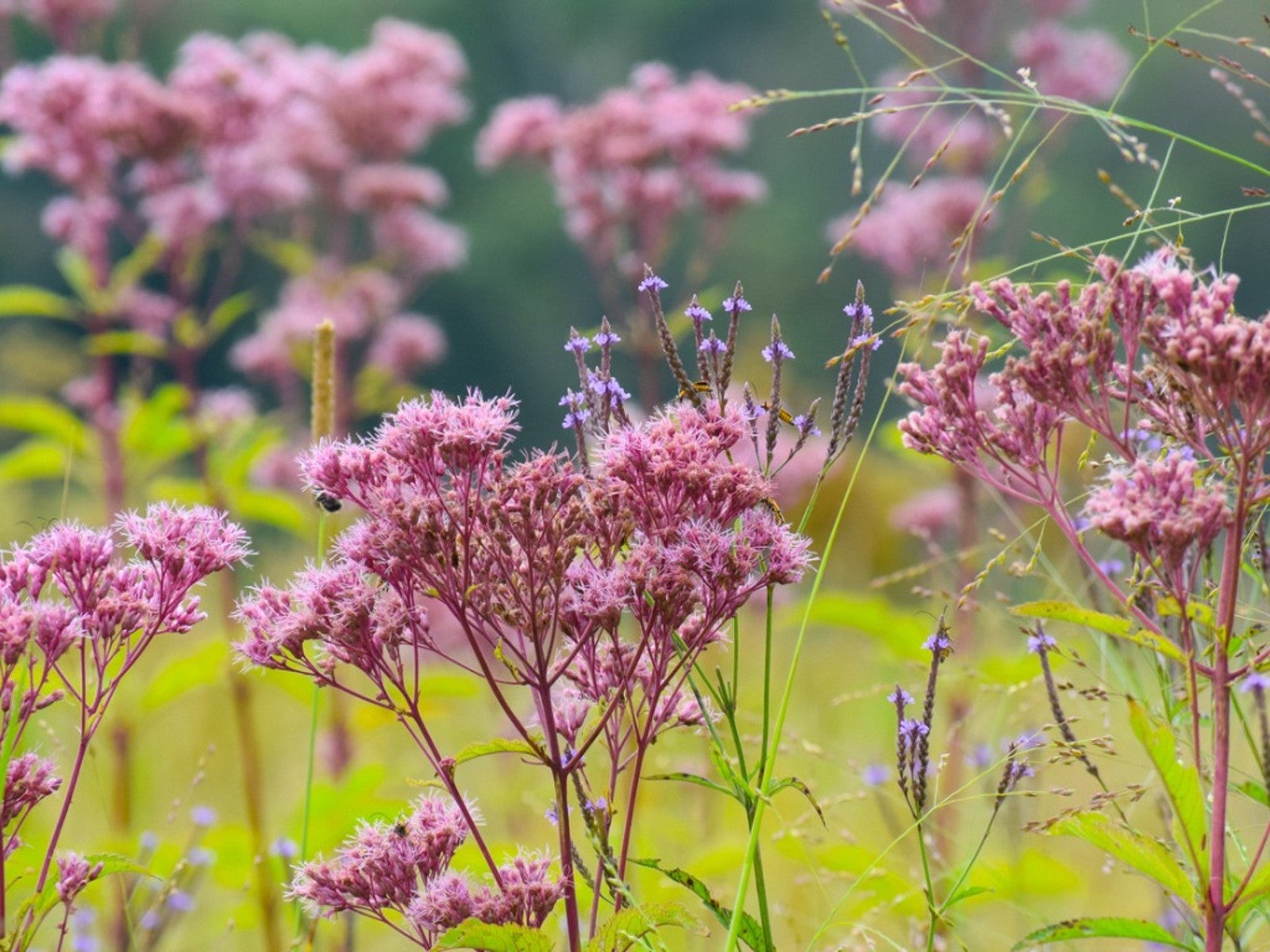Northeast Native Plants For New England And The Mid-Atlantic


There are many good reasons to include native plants in the landscape. Not only are these species well-adapted to the environment and require less care, but they also benefit indigenous animals, birds, and insects. Here's a comprehensive list of native plants Northeast gardeners are sure to love.
Perennial Flowering and Foliage Plants
Whether you're looking for Maryland native plants to add a bit of color to your cottage garden or you're tired of fickle ornamentals in your upstate New York backyard, these native plants will add visual interest to any flowerbed:
- Alumroot (Heuchera americana)
- Aromatic Aster (Symphyotrichum oblongifolius)
- Bee Balm (Monarda fistulosa)
- Blue-eyed Grass (Sisyrinchium angustifolium)
- Blue Iris (Iris versicolor)
- Blue Wild Indigo (Baptisia australis)
- Bugbane (Cimicifuga racemosa)
- Butterfly Milkweed (Asclepias tuberosa)
- Cardinal Flower (Lobelia cardinalis)
- Common Boneset (Eupatorium perfoliatum)
- Common Sneezeweed (Helenium autumnale)
- Culver's Root (Veronicastrum virginicum)
- Cutleaf Coneflower (Redbeckia laciniata)
- Dwarf Crested Iris (Iris cirstata)
- False Solomon's Seal (Smilacina racemosa)
- Foxglove Beardtongue (Penstemon digitalis)
- Garden Phlox (Phlox paniculata)
- Golden Alexanders (Zizia aurea)
- Golden Ragwort (Senecio aureus)
- Great Blue Lobelia (Lobelia siphilitica)
- Green-and-Gold (Chrysogonum virginianum)
- Heartleaf Foam Flower (Tiarella cordifolia)
- Jacob's Ladder (Polemonium reptans)
- Marsh Blazing Star (Liatris spicata)
- Marsh Marigold (Caltha palustris)
- Meadow Bottle (Gentiana clausa)
- New England Aster (Symphyotrichum novae-angliae)
- New York American Aster (Symphyotrichum novi-beggii)
- New York Ironweed (Vernonia noveboracensis)
- Orange Coneflower (Rudbeckia fulgida)
- Ox-eye Sunflower (Heliopsis helianthoides)
- Red Columine (Aquilegia canadensis)
- Scarlet Bee Balm (Monardo didyma)
- Showy Goldenrod (Solidago speciosa)
- Slender Mountain Mint (Pycanthemum tenuifolium)
- Solomon's Seal (Polygonatum biflorum)
- Spotted Cranebill (Geranium maculatam)
- Swamp Milkweed (Asclepias incarnata)
- Swamp Sunflower (Helianthus angustifolius)
- Swamp Verbena (Verbena hastata)
- Sweet Joe Pye Weed (Eutrochium purpureum)
- Tall Coreopsis (Coreopsis tripteris)
- Trumpetweed (Eutrochium fistulosum)
- Turk's Cap Lily (Lilium michiganense)
- Virginia Bluebells (Mertensia virginica)
- White Turtlehead (Chelone glabra)
- White Woodland Aster (Eurybia divaricatus)
- Wild Bleeding Heart (Dicentra eximia)
- Wild Ginger (Asarum canadense)
Ferns
From the western edge of Pennsylvania to the top of Maine, native plants in these fern species are the perfect accent foliage for shady areas of the garden:
- Cinnamon Fern (Osmundastrum cinnamomeum)
- Interrupted Fern (Osmunda claytoniana)
- Marginal Wood Fern (Dryopteris marginalis)
- Northern Lady Fern (Athyrium angustum)
- Ostrich Fern (Matteuccia struthiopteris)
- Royal Fern (Osmunda regalis)
- Sensitive Fern (Onoclea sensibilis)
Grasses, Rushes, and Sedges
Why struggle with non-native species of turf grass and ornamentals in the garden? Try these New England and Pennsylvania native plants instead.
- Common Rush (Juncus effusus)
- Fox Sedge (Carex vulpinoidea)
- Indian Grass (Sorghastrum nutans)
- Little Bluestem (Schizachyrium scoparium)
- Pennsylvania Sedge (Carex pensylvanica)
- Prairie Dropseed (Sporobolus heterolepis)
- Switchgrass (Panicum virgatum)
- Tussock Sedge (Carex stricta)
Bushes
Whether you're looking for blueberry plants that thrive in New Jersey or native hydrangea, Northeast gardeners have an array of indigenous shrubs from which to choose:
- American Hydrangea (Hydrangea arborescens)
- Arrowhead (Viburnum dentatum)
- Buttonbush (Cephalanthus occidentalis)
- Common Witchhazel (Hamamelis virginiana)
- Common Winterberry (Ilex verticillata)
- Cranberrybush (Viburnum opulus)
- Eastern Ninebark (Physocarpus opulifolius)
- Fragrant Sumac (Rhus aromatica)
- Gray Dogwood (Swida racemosa)
- Highbush Blueberry (Vaccinium corymbosum)
- Lowbush Blueberry (Vaccinium angustifolium)
- Nannyberry (Viburnum lentago)
- Red Chokeberry (Aronia arbutifolia)
- Redosier Dogwood (Swida sericea)
- Serviceberry (Amelanchier alnifolia)
- Silky Dogwood (Swida amomum)
- Small Bayberry (Morella caroliniensis)
- Sweet Fern (Comptonia peregina)
- Sweet Pepper Bush (Clethra alnifolia)
Trees
Let's not forget the many species of native trees which comprise acres of forest land in Northeastern United States. These indigenous plants will be at home in backyards throughout the region:
- American Elm (Ulmus americana)
- American Holly (Ilex opaca)
- American Hornbeam (Carpinus caroliniana)
- Blackgum (Nyssa sylvatica)
- Eastern Redbud (Cercis canadensis)
- Eastern Red Cedar (Juniperus virginiana)
- Flowering Dogwood (Cornus florida)
- Northern Red Oak (Quercus rubra)
- Pawpaw (Asimina triloba)
- Pin Oak (Quercus palustris)
- Red Maple (Acer rubrum)
- River Birch (Betula nigra)
- Sugar Maple (Acer saccharum)
- White Oak (Quercus alba)
- White Pine (Pinus strobus)
Gardening tips, videos, info and more delivered right to your inbox!
Sign up for the Gardening Know How newsletter today and receive a free copy of our e-book "How to Grow Delicious Tomatoes".

Laura Miller has been gardening all her life. Holding a degree in Biology, Nutrition, and Agriculture, Laura's area of expertise is vegetables, herbs, and all things edible. She lives in Ohio.